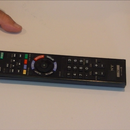Introduction: Radio Controlled Starship
I had an idea in my head that just wouldn't leave. I am a fan of the star Trek television series. The Star Ship Enterprise is an Icon for my generation. I had an idea that would let it fly RC. The "deflector" pod below the engines looked like it would act as a vertical stabilizer if the plane was built in profile. As I visualized it, it was apparent that the plan form was an exploded delta configuration. I have good results with delta like configurations. They have a wide speed range, don't tip stall readily and are inherently stable. Laminated construction foam ( R-GARD ) had proven to be a cheap, strong and light weight material that would be perfect for this project. The foam itself is very light and flimsy, but becomes amazingly strong with the front and back vapor barrier laminations. First I went to the internet to look for pictures of the ship. I enlarged them to the scale I wanted using a free CAD program called TURBO CAD. This gave me dimensions and also, when printed out, a detailed covering. TURBO CAD allows you to tile print using your normal printer. Tile printing divides the image into many 8.5" x 11" pages that you print and tape together. Alternatively you can take the image to a print shop and have it printed as one piece of paper. Much of the construction details can be seen by expanding the photos and the plans pdf.
Supplies
24' x 48" R-GARD foam board
4 1/8" x 12" paint sticks
1 foam take home food box
8 12" bamboo skewers
packing tape
S400 motor with 5x5 or 6 x 4 prop ( or brush less equivalent)
7-8 cell 600 mah NiCad battery ( or 3cell Lithium Polymer)
Velcro
2 micro servos (HS-55)
1 micro receiver (GWS)
one 10 amp ESC (SIRIUS)
Foam safe silver or gray paint
Foam safe glue ( polyurethane)
Step 1: 24' X 48" 3/4" R-GARD Foam Board
Foam cut out. One piece is recommended to maintain alignment.
Step 2: Bamboo Stiffener
Bamboo stiffener to strengthen disk to engine pod joint strength
Step 3: Tongue and Groove Joint
I dug out foam in the deflector pod to insert a paint stick. The outline was traced to show the where the struts would attach to.
Paint sticks were cut to 3/4" width and recessed into a 1/4" channel in the disk bottom. The double paint sticks at the rear allow for a tongue and groove joint for the deflector pod. Polyurethane glue was used when possible. It expands into the foam while curing providing an exceptionally strong joint. The sticks will also be the engine mount.
Step 4: Note the Bamboo Skewer at the Rear
Bamboo skewers are the deflector pod to engine pod struts.
This keeps the engine pod alignment under load. (warp speed)
Bamboo skewers are used throughout. First one is pierced through the engine pod into the disk for strength. Two per side are used as stringers between the deflector pod and engine pods. These are later covered with painted foam from take home food trays. (depron)
Step 5: Elevons Are Cut and Beveled.
They seem big and they need to be that way. The "plane" flies slow and the controls are not in the prop wash.
Elevon controls are simple. to save weight at the rear of the plane, I used 1/16" music wire ( z bends at each end ) with a support half way down the length. The control horns are 1/64" plywood glued into a slot on the elevon.
Step 6: Leading Edge
A channel is cut in the edge of the disk and then taped closed. (aerodynamic look) You can skip this step as the block foam edge is draggy but so is the entire "plane".
Step 7: Servo Placement
Pieces of take home food tray foam are butt jointed and taped to get long pieces for the engine pods.Servos are glued in place after you either paint ( foam safe paint ) or cover with printed paper.The profile portion of the top and bottom of the disk are cut out of food tray foam and glued on. Using paper to laminate the bottom profile on the paint stick provides a strong joint.The S400 motor is installed in a cutout at the rear of the disk exposing the motor mount sticks embedded into the foam (tongue and groove). I like to use plastic banding strips that I tighten around the motor and motor mount with a screw.
Step 8: Final Touches
Batteries are mounted on the top of the disk with Velcro. Using the battery, balance the center of gravity 10 - 11 inches from the leading edge. Try to build the tail areas light as possible. This helps to get the CG easier with a standard battery. Flying is straight forward holding the lower disk "hull" in front of the deflector pod. Toss straight ahead allowing some speed to accumulate before turns. The control surfaces are not in the prop wash so model speed is crucial to having any control authority. While I have not tried loops or rolls, the "plane" is very responsive to controls. Deltas can fly at a high angle of attack, hanging, if you will, on the prop. Coming in for a landing gracefully is helped by not waiting to the end of battery life. Flair a foot from the ground with additional power allows it to settle almost vertical, like an autogyro. Expect an audience. The pusher prop is somewhat hidden giving and illusion of "mystery" power. I unintentionally stopped a girls softball game when the coaches and fathers came over to see what it was.





